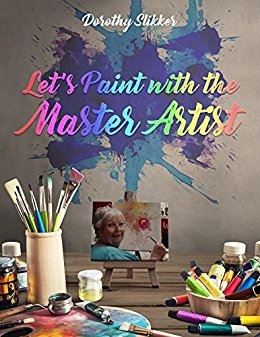Let's Paint with the Master Artist
This instructional art book passes on lessons from a master.
Artist and teacher Dorothy Slikker’s Let’s Paint with the Master Artist seeks to impart an artistic technique developed by the author’s teacher, Robert Warren.
Eleven of Slikker’s paintings are shared as examples of the Warren technique, the essence of which involves laying down an undercoat of luminous orange wash topped with clear medium to create a pentimento glow and sense of watercolor-like fluidity. The paintings chosen include landscapes, animals, and one portrait; they are done on canvases with oils, acrylics, a variety of brushes, and palette knives.
Unpretentious, friendly, and encouraging, the book is aimed at anyone who would like to paint but fears they don’t have the talent. It argues that through attention to composition, technique, and practice, most people will be able to create their own art and have a good time doing so. Still, the related techniques seem better suited to live demonstrations than to instructions delivered in print.
The book is specific when it comes to choosing colors, mixing colors, and color placement and layering, and includes useful tips on recognizing complementary colors and split complementaries. However, the included color wheel, meant to be cut out and used, appears lopped off and is positioned upside-down.
The work is disorganized, without chapters, a table of contents, an index, or a glossary. The presentation of the first painting is especially confusing; its construction is shared in a jumbled manner, beginning with a reference to painting clouds, followed by instructions for canvas prep, and concluding with notes on the placement of trees. The order of these steps is unclear.
Such sketchiness recurs, with directives like “add 5 trees” and “paint just the nubs on the canvas” coming without actual instructions. Notes early in the book include helpful reminders, such as the fact the cool colors recede, but do not follow any logical order and are interspersed with subjective personal advice, like thinking of oneself as an entertainer rather than an artist, and rejecting negative criticism. Homonyms, misspellings, grammatical errors, and incoherent sentences require audience patience.
A section on portrait painting is the longest, best thought-out, and most clearly written. It includes detailed guidelines on how to sketch the proportions of a face, how to position portraits of both men and women on a canvas, and how to assess and sketch the details that give a face individuality. Also included are a chart on mixing skin tones and useful directions for challenging details like eyes, lips, and teeth.
Let’s Paint with the Master Artist is a sometimes unclear instructional art book that teaches aspiring painters how to achieve a luminous canvas under-glow.
Reviewed by
Susan Waggoner
Disclosure: This article is not an endorsement, but a review. The publisher of this book provided free copies of the book and paid a small fee to have their book reviewed by a professional reviewer. Foreword Reviews and Clarion Reviews make no guarantee that the publisher will receive a positive review. Foreword Magazine, Inc. is disclosing this in accordance with the Federal Trade Commission’s 16 CFR, Part 255.

